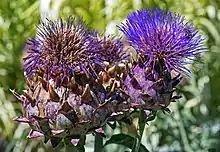Cardueae
The Cardueae are a tribe of flowering plants in the daisy family (Asteraceae) and the subfamily Carduoideae.[5] Most of them are commonly known as thistles;[6] four of the best known genera are Carduus,[7] Cynara (containing the widely eaten artichoke), Cirsium,[7] and Onopordum.[7]
| Cardueae | |
|---|---|
 | |
| Artichoke flower head | |
| Scientific classification | |
| Kingdom: | Plantae |
| Clade: | Tracheophytes |
| Clade: | Angiosperms |
| Clade: | Eudicots |
| Clade: | Asterids |
| Order: | Asterales |
| Family: | Asteraceae |
| Subfamily: | Carduoideae |
| Tribe: | Cardueae Cass. (1819)[1][2] |
| Subtribes | |
|
Cardopatiinae[3] | |
| Synonyms[1] | |
| |
They are annual, biennial, or perennial herbs. Many species are thorny on leaves, stems, or involucre, and some have laticifers or resin conduits. Almost 80 genera comprising 2500 species are assigned to this tribe,[8] native of temperate regions of Europe and Asia (especially the Mediterranean region and Minor Asia), Australia and tropical Africa; only three[9] genera contain species native to the Americas.[10]
Taxonomy
The correct name for the tribe has been disputed. In 1806, Jean-Baptiste Lamarck and Augustin Pyramus de Candolle published the name Cynarocephalae. This is a descriptive name, referring to the bluish colour of the flower heads. Such descriptive names for tribes are not valid under the International Code of Nomenclature for algae, fungi, and plants, which requires them to be based on a generic name. The name has been corrected by some authors to Cynareae, but this was not the name that was published in 1806. Christian Friedrich Lessing published Cynareae in 1830, but Henri Cassini had already published Cardueae in 1819, and as Lessing included Carduus in Cynareae, his name was superfluous.[4][2]
Some authors have divided the plants traditionally held to be in this tribe into three tribes: Cynareae in the narrow sense, Carlineae, and Echinopeae. However, other authors have retained the traditional broader classification.[11]
Subtribes and genera
- Arctiinae Garcia-Jacas & Susanna
- Berardiinae Garcia-Jacas & Susanna
- Berardia Vill.
- Cardopatiinae Less.
- Cardopatium Juss.
- Cousiniopsis Nevski
- Carduinae Dumort.
- × Carduogalactites P.Fourn.
- × Cirsio-carduus P.Fourn.
- Carduus L.
- Cirsium Mill.
- Cynara L.
- Galactites Moench
- Lamyropsis (Kharadze) Dittrich
- Notobasis (Cass.) Cass.
- Picnomon Adans.
- Ptilostemon Cass.
- Silybum Adans.
- Tyrimnus (Cass.) Cass.
- Carlininae Dumort.
- Atractylis L.
- Atractylodes DC.
- Carlina L.
- Thevenotia DC.
- Tugarinovia Iljin
- Centaureinae Dumort.
- Amberboa (Pers.) Less.
- Callicephalus C.A.Mey.
- Carduncellus Adans.
- Carthamus L.
- Centaurea L.
- Centaurodendron Johow
- Centaurothamnus Wagenitz & Dittrich
- Cheirolophus Cass.
- Crocodilium Hill
- Crupina (Pers.) DC.
- Femeniasia Susanna
- Goniocaulon Cass.
- Karvandarina Rech.f.
- Klasea Cass.
- Leuzea DC.
- Mantisalca Cass.
- Myopordon Boiss.
- Nikitinia Iljin
- Oligochaeta (DC.) K.Koch
- Phalacrachena Iljin
- Phonus Hill
- Plagiobasis Schrenk
- Plectocephalus D.Don
- Psephellus Cass.
- Rhaponticoides Vaill.
- Russowia C.Winkl.
- Schischkinia Iljin
- Serratula L.
- Stizolophus Cass.
- Tricholepis DC.
- Volutaria Cass.
- Zoegea L.
- Dipterocominae Garcia-Jacas & Susanna
- Dipterocome Fisch. & C.A.Mey.
- Echinopsinae Dumort.
- Echinops L.
- Onopordinae Garcia-Jacas & Susanna
- Alfredia Cass.
- Ancathia DC.
- Lamyropappus Knorring & Tamamsch.
- Olgaea Iljin
- Onopordum L.
- Synurus Iljin
- Syreitschikovia Pavlov
- Xanthopappus C.Winkl.
- Saussureinae Garcia-Jacas & Susanna
- Staehelininae Garcia-Jacas & Susanna
- Staehelina L.
- Xerantheminae Cass. ex Dumort.
- Amphoricarpos Vis.
- Chardinia Desf.
- Shangwua Yu J.Wang, Raab-Straube, Susanna & J.Quan Liu
- Siebera J.Gay
- Xeranthemum L.
References
- Compositae Working Group (CWG), "Cardueae Cass.", Global Compositae Database, retrieved 2023-05-12
- "trib. Cynareae Less." The International Plant Names Index. Retrieved 2023-05-12.
- Susanna, Alfonso.; Garcia-Jacas, Núria; Hidalgo, Oriane; Vilatersana, Roser; Garnatje, Teresa (2006). "THE CARDUEAE (COMPOSITAE) REVISITED: INSIGHTS FROM ITS, trnL-trnF, AND matK NUCLEAR AND CHLOROPLAST DNA ANALYSIS1, 2" (PDF). Annals of the Missouri Botanical Garden. 93: 150–171. doi:10.3417/0026-6493(2006)93[150:TCCRIF]2.0.CO;2. hdl:10261/29764.
- "trib. Cynarocephalae Lam. & DC." The International Plant Names Index. Retrieved 2023-05-12.
- Panero, JL; VA Funk (2002-12-30). "Toward a phylogenetic subfamilial classification for the Compositae (Asteraceae)" (PDF). Proceedings of the Biological Society of Washington. Biological Society of Washington. 115 (4): 909–922. Archived from the original (PDF) on 2006-09-14. Retrieved 2007-08-12.
- "Cardueae". Tree of Life webproject. Retrieved 2012-10-31.
- "thistle". Merriam-Webster's online dictionary. Retrieved 2007-11-30.
- Dittrich, 1977, The Biology and Chemistry of the Compositae 2:1017-1038
- "Cirsium". Flora of North America.
- Bremer 1994 Asteraceae: Cladistic and Classification [Tribe Carduae: 112-156]
- "tribe Cynareae". Flora of North America. Retrieved 2008-01-04.